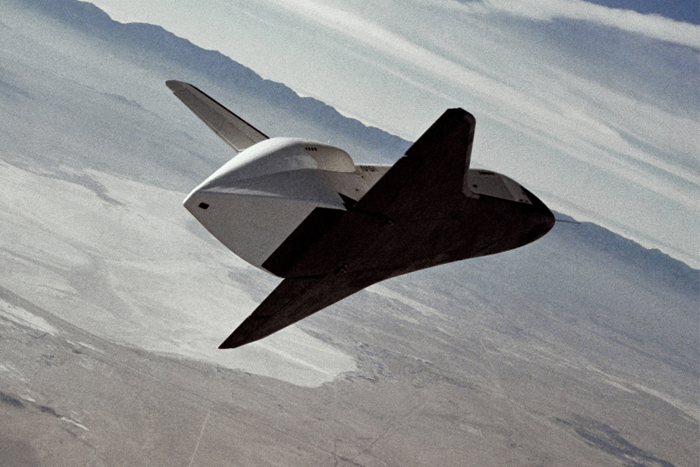Space History Photo: Shuttle Enterprise Free Flight

In this historical photo from the U.S. space agency, the Space Shuttle prototype Enterprise flies free after being released from NASA's 747 Shuttle Carrier Aircraft (SCA) over Rogers Dry Lakebed during the second of five free flights carried out at the Dryden Flight Research Center, Edwards, California, as part of the Shuttle program's Approach and Landing Tests (ALT). The tests were conducted to verify orbiter aerodynamics and handling characteristics in preparation for orbital flights with the Space Shuttle Columbia beginning in April 1981. A tail cone over the main engine area of Enterprise smoothed out turbulent air flow during flight. It was removed on the two last free flights to accurately check approach and landing characteristics.
A series of test flights during which Enterprise was taken aloft atop the SCA, but was not released, preceded the free flight tests. The Space Shuttle Approach and Landing Tests (ALT) program allowed pilots and engineers to learn how the Space Shuttle and the modified Boeing 747 Shuttle Carrier Aircraft (SCA) handled during low-speed flight and landing.
The Enterprise, a prototype of the Space Shuttles, and the SCA were flown to conduct the approach and landing tests at the NASA Dryden Flight Research Center, Edwards, California, from February to October 1977. The first flight of the program consisted of the Space Shuttle Enterprise attached to the Shuttle Carrier Aircraft. These flights were to determine how well the two vehicles flew together. Five "captive-inactive" flights were flown during this first phase in which there was no crew in the Enterprise. The next series of captive flights was flown with a flight crew of two on board the prototype Space Shuttle. Only three such flights proved necessary. This led to the free-flight test series. The free-flight phase of the ALT program allowed pilots and engineers to learn how the Space Shuttle handled in low-speed flight and landing attitudes.
For these landings, the Enterprise was flown by a crew of two after it was released from the top of the SCA. The vehicle was released at altitudes ranging from 19,000 to 26,000 feet. The Enterprise had no propulsion system, but its first four glides to the Rogers Dry Lake runway provided realistic, in-flight simulations of how subsequent Space Shuttles would be flown at the end of an orbital mission. The fifth approach and landing test, with the Enterprise landing on the Edwards Air Force Base concrete runway, revealed a problem with the Space Shuttle flight control system that made it susceptible to Pilot-Induced Oscillation (PIO), a potentially dangerous control problem during a landing. Further research using other NASA aircraft, especially the F-8 Digital-Fly-By-Wire aircraft, led to correction of the PIO problem before the first orbital flight.
The Enterprise's last free-flight was October 26, 1977, after which it was ferried to other NASA centers for ground-based flight simulations that tested Space Shuttle systems and structure.
Each weekday, SPACE.com looks back at the history of spaceflight through photos (archive).
Get the Space.com Newsletter
Breaking space news, the latest updates on rocket launches, skywatching events and more!
Join our Space Forums to keep talking space on the latest missions, night sky and more! And if you have a news tip, correction or comment, let us know at: community@space.com.

The National Aeronautics and Space Administration (NASA) is the U.S. government agency in charge of the civilian space program as well as aeronautics and aerospace research. Founded in 1958, NASA is a civilian space agency aimed at exploring the universe with space telescopes, satellites, robotic spacecraft, astronauts and more. The space agency has 10 major centers based across the U.S. and launches robotic and crewed missions from the Kennedy Space Center in Cape Canaveral Florida. It's astronaut corps is based at the Johnson Space Center in Houston. To follow NASA's latest mission, follow the space agency on Twitter or any other social channel, of visit: nasa.gov.









